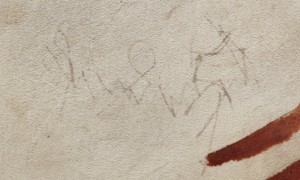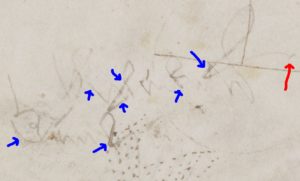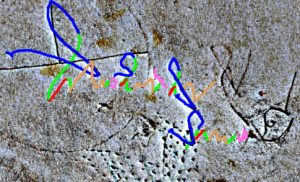As a Voynich Manuscript marginalia cognoscente, I’m always alert for new angles on the various incidental marks apparently added by its later owners. So, when Tim Tattrie left a comment about the “chicken scratch” marginalia on my recent Voynich-frontiers-circa-2010 post, I thought it was probably time to revisit them here.
Tim’s query was whether anyone had pursued the initials scribbled on f66v and f86v3: he noted that these were “clearly the same downward swept doodle of two or three letters (h?r), and because it is repeated in two folios, leads one to speculate its the initials of either the author, or an owner.” This almost exactly echoes what Jon Grove said on the Voynich mailing list (11 Sep 2002), that “It seems to consist of three connected downstrokes followed by a longer upstroke with a loop and final flourish, almost like ‘wR’ but not quite. It’s certainly not a random scribble. If it is a signature or monogram then it might help to establish dates and/or locations for the MS. ” To which Dana Scott replied at the time: “Notice that the single line ‘signature’ in f66v is essentially the same as the top line ‘signature’ in f86v (there are some differences to the right of each line).”
OK, so let’s look at them in all their hi-res glory. Firstly, the chicken scratches on f66v:-
And now here are the chicken scratches on f86v3. Palaeographically, I think this is much more interesting, because you can see what looks like a scribal line ending stub (in red), and lots of places where the quill has opened up under pressure in different directions (in blue). Some years ago, I suggested that these scratches might be an ink blot transfer of Georg Baresch’s signature, because if you rotate and flip them you can see letter-sequences that vaguely resemble “g///g”:-
However, there is a codicological nicety to consider here, which is that if you reorder Q8 (Quire #8) to place the astronomical (non-herbal) pages at the back, and also follow Glen Claston’s suggestion by inserting the nine-rosette quire between (the reordered) Q8 and Q9, what you unexpectedly find is that the f66v and f86v3 chicken scratches move extremely close together. If this is correct, it would imply that the doodles were added very early on in the life of the VMs, probably earlier even than the fifteenth-century hand quire numbering (and hence probably early-to-mid 15th century). And this would rule out Baresch by a couple of centuries or so. 🙂
But I have a possible bombshell to drop here. If I once again rotate and reverse the f86v3 chicken scratch, this moves the ornate scribal line-ending to the start, implying that it was the start of a line. Following the lines through from there on a Retinex-enhanced version of the page, I now suspect we know enough to separate out the letters one at a time:
If I’ve got this correct, then the letter sequence here is:-
- (blue) “S“
- (green) downstroke
- (red) “i“
- (green) downstroke
- (orange) “m“
- (green) downstroke
- (purple) “o” / “n” / “t” [though it’s not entirely clear which]
So, something like “Simon”, then. What is particularly curious is that I have elsewhere suggested that the top-line marginalia on f116v reads “por le bon simon sint” in what I suspect was the handwriting of either the original author or someone very close to him/her. If that is right, then we can piece together a little bit of the VMs’ early 15th century provenance: that what we are looking at here is the ink blot signature of someone named (something close to) “Simon Sint”, who was very possibly the person to whom that original author gave the manuscript. Though it’s hard to be sure, this person may well be the same one who added the earliest set of quire numbers (which I called “Quire Hand 1” in The Curse)… but we’ll leave that issue for another day, that’s probably quite enough wobbly inferences for one post! 🙂
OK, as explanations go it’s not 100% convincing as yet, but all the same it’s a pretty joined-up historical hypothesis that could (and indeed should) be codicologically tested, which is more than can be said about most speculative VMs theories. I’m pretty sold on the idea that this is telling us we should be looking for someone (possibly a monk) in Southern France / Savoy called something not too far from “Simon Sint” circa 1450, and that this is his signature (i.e. he cared so little about the VMs that he used it as blotting paper, shame on him). Jeez, how specific do I need to be? 🙂



bleed from a bookmark used twice?
Don: each of the “Sim..”s is slightly different (sizes, shapes, angles, etc), so I’m reasonably sure they’re not all from the same source.
The question then comes: what situation would our putative “bon” Simon Sint have been in that he would be signing things but not writing things? Would he have been (for example) a high-up monk where scribes would be writing his correspondence, and he would merely be signing it? Something to think about… 🙂
maybe not sint but seint? Assuming that it’s dutch.
Diane: please have another look at the marginalia where I think the name appears – there’s discussion on this page here – and see what you think. It may well be that by combining the f116v top line with the f86v3 chicken scratches we can infer more information than if we treated them as unconnected…
I’m not fluent in modern Dutch, let alone medieval, but as far as I know, that’s the only language in which we have “sint” isn’t it?
(The posited ‘p’ reminds me so much of a Hebrew letter that it throws me..
Anyway, if it’s Dutch, or an effort to write in the English-Franglish which was the trader’s common language of the VMs time of writing, then you have other possibilities:
bon …credit note; cheque; voucher
sint … an effort to replicate “sent” [Dutch: seint].
which would give something akin to
for credit/receipt [.] per/by Simon[.]
making Simon the one who delivers goods or receipt.. something like that, perhaps.
That is – there’s no necessary connection between what was on the over-inked slip and the content of the VMs is there?
Diane: with only a few emended letters on f116v and some inkblotted signatures on f86v3, it’s hard to be sure – I use “simon sint” merely as my best palaeographic guess, not as a statement about nationality or language. Savoy is similarly my guess based on the f116v marginalia’s apparent French-ness (and the Occitan-like month-names added to the zodiac section). Despite the mass of guesswork, I’m still confident that this stands a good chance of helping us reach out towards something genuinely useful about the VMs’ hazy origins. The only likely connection is through ownership – f116v holds a note written to the putative “simon sint”, while the f86v3 looks to me like an ink-blot signature by the putative “simon sint”. But my crystal ball is hazy beyond this point… 🙂
Hi Nick —
I’ve been staring at f86v3 for months, off and on, and since you’ve returned to it, I may as well toss in my thoughts. I don’t pretend to grasp all the scribbles, but at this point I have a hard time seeing parts of them except in one way: the initials “WR” repeated four times, generally moving from lower left to upper right. Here’s a photo that shows what I think is happening: ftp://216.158.2.41/photos/wr.jpg
I picture someone practicing a monogram, or distractedly doodling their own or maybe a lover’s initials. There’s emotion involved — as you noted, you can see where the person pressed so hard on the page that the quill split (something I used to get in trouble for with my grandfather’s fountain pen!). The handwriting generally becomes larger and less controlled from left to right.
I think there are a couple of “wobbly inferences” available. First, the writer’s judgment was impaired, perhaps by strong emotion, alcohol, or simply youth (this could have been a child writing on dad’s book). Second, as you point out, the writer did not personally pay a bunch of ducats for the book and probably didn’t realize it was valuable (or alternatively, didn’t care — call it the “drunk teenager” theory). I don’t really see much in these scribbles (apart from their bare presence) that justifies the inference of a connection, either textually or via ownership, with the other contents of the VMS.
I did have a momentary vision of a drunk, sleepless and desperately frustrated Professor “WR” Newbold slumping over his desk at 3:00 a.m., quill in hand, but I suppose not.
Jim Shilliday
Jim: other people have similarly seen multiple sets of “hR” or “wR” when looking at this page. For me, though, the part that doesn’t quite fit is #4 in your diagram – specifically the scribal ‘end-cap’ to the end of the “R”. I’m only really comfortable with that as the startpoint of a letter-group, not as an endpoint. Of course, this isn’t exactly a scientific proof, but it is at least some kind of reasoning why I chose one direction over the other (long before noticing the possible connection with the top line of f116v). Thanks for your comment! 🙂
My (late) medieval Dutch isn’t what it used to be centuries ago, but I cannot place ‘seint’ at all, I’m afraid. Sint is modern Dutch for Saint.
Possibly, this does not matter too much, since the word (whether it be sint or seint) doesn’t actually appear in the MS, if I read all the posts correctly…
Interesting topic though.
Cheers, Rene
Rene: that’s right, I only really use “sint” as a placeholder until such time as someone gets around to doing a more definitive scan of f116v, in much the same way that we talk about the “michiton hand”. 🙂
I confess: ‘seint’ is probably only in modern Dutch, where the usual translation is “transmit.” It may well not exist in medieval Dutch, and I cheerfuly defer to Rene’s opinion of it.
The chicken scratchings look not unlike some graffiti found in the Sinai. It was Arabic without the diacritics.
Ill email you a copy of a photograph of it.
And – this is probably way off the mark – but one of the Telchines was named Simon; another was Zenob. Chief centres Rhodes and Crete.
The founder of the English Carmelites, Saint Simon Stock, who received the gift of the Brown Scapular in 1254 or thereabouts, is buried at Aylesford monastery.
I know this is late and old school, but How does the initial shape of these two scratches match up to the large single ‘scratch’ on f87r?
https://www.jasondavies.com/voynich/#f87r/0.422/0.598/3.20
to me, they look very similar (referring to the second blue arrow from the left on your diagram for f86v3)